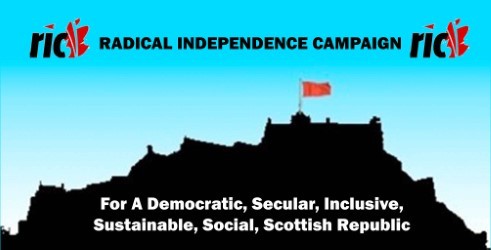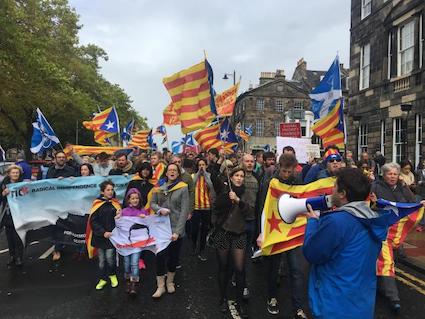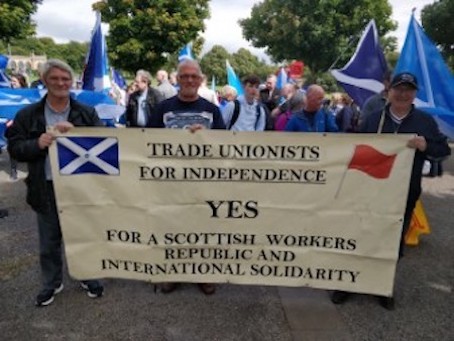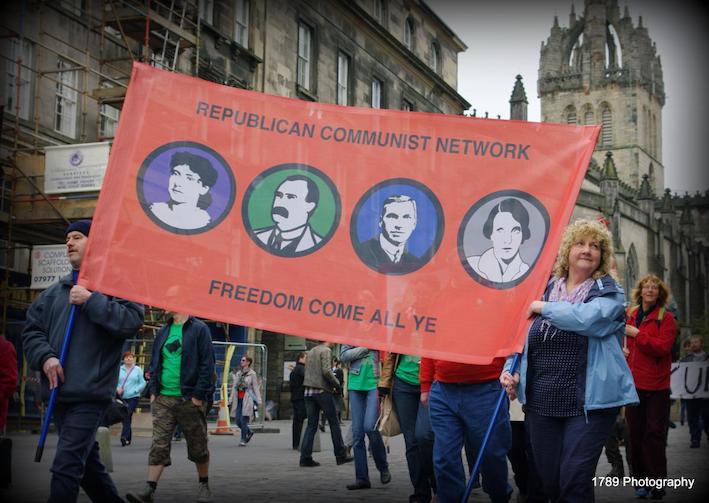On 3rd February 2021, bella caledonia published an article by Allan Armstrong, Freedom Come All Ye. This included an analysis of the politics behind the attempt by the Terminators to shut down RIC nationally. Since then, a provisional ‘Yes Alba’ has also morphed into ‘Now Scotland’. Allan’s original article has been updated to take in these latest events.
Freedom Come All Ye at bella caledonia

From ‘Shy Imperial Bombast’ to the full panoply of the UK state’s Crown Powers
Mike Small’s article Shy Imperial Bombast</cite? (31st January 2021) continues his very welcome chronicle of UK unionist and imperial decline. This was highlighted by ‘IndyRef1’ in 2014. Originally backed by the Tories, Lib-Dems and New Labour alike, to marginalise the SNP, then led by the cocky Alex Salmond, all their ‘victory’ did was mainstream Scottish independence as a major political issue in the UK.
This was followed by the 2016 Brexit vote to ‘bring back control’ to the highly centralised and anti-democratic UK state. In the process, the ‘federalism’ and ‘parity of esteem’ promised to the three nations and one province of the UK state in 2014, have been quickly abandoned. Scotland, Northern Ireland and Welsh-speaking Wales voted to Remain in the EU. Therefore, Brexit can only be imposed by rolling back the limited democratic concessions that have been place since the post-1998 ‘Devolution-all-round’ settlement.
Mike joins many people in Scotland in their sheer incredulity over Johnson’s visit to Scotland on January 28th. Johnson thinks he can persuade us of the benefits of the Union and Brexit! We are already European leaders – in Covid-19 death rates! However, this visit wasn’t just typical individualist Johnson bombast. This was shown by Sir Keir Starmer’s and Jackie Baillie’s support for Johnson’s visit. Starmer has belatedly realised that the majority of the British ruling class now supports Brexit. The Bank of England governor, Mark Carney’s backing for Johnson’s Brexit deal prior to the 2019 Westminster general election should have alerted Starmer to this already. However, Starmer’s no. 1 priority at the time was to extinguish the threat represented by then British Labour leader, Jeremy Corbyn. As opinion poll ratings for the Tories climbed steadily in England and Wales, British employers were licking their lips at the prospect of rolling back existing worker, consumer and environmental regulations.
Now that Starmer can see the majority of the British ruling class wants Brexit, he has quickly fallen into line. British Labour is to return to its Blairite strategy of providing ‘fire and theft’ insurance for the ruling class. Hence Johnson’s and Baillie’s socially-distanced ‘Better Together’ appeal last week to uphold the Union. However, trying to out-unionist the Tories on these political grounds only highlights the Scottish Labour ‘branch office’ disconnect from any reality in Scotland.
Too much focus on Johnson’s apparent bumbling ineptitude disguises the real source of his power. We don’t live in a democracy, where sovereignty lies with the people, or even with Westminster, but with the Crown-in-Westminster. The Crown has very little to do with monarchy (obscenely privileged though it is), but with a formidable range of anti-democratic Crown Powers, which it fronts. This includes emergency rule by the Privy Council without the necessity for any unsavoury coup. Johnson might have slightly overstepped the mark, with his attempt to prorogue Westminster in his August 2018 ‘coup’, but he only received the mildest rap over the knuckles He had to give ‘Elizabrit’ an apology. The awe in which constitutional politicians hold the Privy Council was shown by Jeremy Corbyn, whilst still Labour leader, and by Nicola Sturgeon continuing to accept that the business the ruling class chooses to divulge to them remains a secret. This knowledge is not be shared with their parties, Westminster or Holyrood, and certainly not with the people.
The looming May 2021 Holyrood election and politics on the streets
Thus, even if the very timid SNP government wins this May’s Holyrood election, as seems likely, and proceeds with a consultative ballot on independence, ‘IndyRef2’, this is far from the end of the game for the British ruling class. We have already witnessed how another unionist government in Spain (using the semi-Francoist constitution and state apparatus, rather than any Crown Powers) has dealt with such a referendum in Catalunya. And anyone who argues that British ruling class wouldn’t resort to such methods is ignoring their record in Ireland. In the 1960s, the Northern Ireland Civil Rights Movement began by calling for Catholics to have the same civil rights that existed elsewhere in the UK and not be discriminated against. Her majesty’s 1st Battalion of Parachutists’ killing spree in Ballymurphy in 1970 and ‘Bloody Sunday’ in Derry on 30.1.71, led to more than thirty years of repression. Bernadette McAliskey has termed the shocked response in the growing Irish nationalist ‘communities of resistance’ as “republicanism for slow learners”.
But such a resort to violence is not likely to be the immediate response of Johnson’s government and the UK state in Scotland, in the event of a majority SNP majority government in May. The SNP leadership fully accepts the sovereignty of the Crown-in-Westminster, and its devolved Holyrood offspring. Their acceptance provides the UK state with a whole range of other political possibilities. These could include more meaningless ‘vows’ about future ‘federalism’ – a constitutional impossibility, when sovereignty lies with the Crown-in-Westminster. A time wasting Royal Commission is another possibility. Or an independence referendum may actually be held, but on UK government terms with abstentions counted as ‘Nos’, or a two thirds majority threshold. There could also be a rigged franchise, such as that in the 2016 Brexit referendum, with an electoral roll based on British ethnic criteria to undermine the civic national basis and opening up to 16-18 year old voters, which underpinned ‘IndyRef1’ in 2014.

The British Labour Party has form in all of these derailing activities. This underscores their central ‘fire and theft’ insurance role for the British ruling class. But if necessary, Labour can dredge even lower. This was shown by Gordon Brown’s right populist resort to “British Jobs for British workers” borrowed from the neo-fascist BNP and the earlier National Front; or by Labour controlled Glasgow City Council’s overtures to the Orange Order and sponsorship of the OrangeFest in 2015.
Politics in Scotland are now coming to a new watershed. This has been the background to a number of key events which have been held here over the last few months. However, first there is a non-event – no SNP conference to discuss Plan B, in the face of Johnson’s Tory government refusing to sanction a `Section 30’ order. Clearly the SNP leadership has gone out of its way to suppress any voices suggesting that the party may need a back-up option. This has led to high tension and acrimony within SNP ranks. Indeed, the SNP has become the focus of a potential political ‘bloodbath’.
This has been highlighted by Alex Salmond’s successful challenge to her majesty’s Advocate over what appears to have been an SNP leadership attempt to pervert the course of justice. This has been followed by Salmond’s stepped-up challenge to the SNP inner coterie and its backers. But “sex pest” (his defence lawyer’s phrase) Salmond has no extra-constitutional strategy to challenge the UK state.
The second very public indication of a deep divide has been Nicola Sturgeon’s sacking of Joanna Cherry on February 1st. This has been described as a “civil war” in the SNP. Cherry, an ambitious careerist, has attempted to cultivate a more fundamentalist section of the party base with its unresolved prejudices. But she is even less likely than Salmond to challenge the UK state or break from the SNP.
Beyond this particularly torrid zone of Scottish politics lie the Scottish Independistas, who initially organised as ‘All Under One Banner’ (AUOB); and the Left wing of the movement for Scottish self-determination, the Radical Independence Campaign (RIC). Both have held recent well attended online conferences, indicating the intensified interest in Scottish politics, as the wider political situation opens up.
This contrasts with England, where there has also been a series of online conferences. These have tried to account for the collapse of Labour Left project there on December 12th, 2019. The follow-up Corbynite candidate for Labour leader, Rebecca Long-Bailey, began by saying that, if she ever became the UK prime minister, she was quite prepared to press the nuclear button! With this inauspicious start, the Labour Left’s prolonged post-December 12th autopsy has neither been able to give their failed project a decent burial, or to find the seeds of any meaningful renewal. They are so focussed on England (or often just London) they remain largely unaware that the main challenge to Johnson comes from the rising movements for national self-determination in Scotland, Ireland and Wales. Whilst Right unionists see the UK state as a vehicle for maintaining their class privileges, the Left unionists see the UK state as the necessary framework for their reforms. Any national self-determination movements which challenge this are seen as a threat.
So, unlike the Left in England (with a few Left unionist hangers on in Scotland, Wales and even Northern Ireland), the Independistas’ and Scottish Left’s continuing engagement in wider Scottish politics represents something real and is a vital debate.
From ‘All Under One Banner to ‘Now Scotland’ and the Catalan connection?

George Kerevan, a recent SNP MP and now a party dissident, has been the leading light behind the new ‘Now Scotland’. This represents an attempt to politicise ‘All Under One Banner’ (AUOB) originally initiated by the Independistas. This means going beyond AUOB’s organisation of very impressive demonstrations to challenging an SNP leadership, increasingly bereft of ideas, for the leadership of the Scottish independence movement. George is quite rightly concerned that any future referendum campaign should not be managed in the same manner as the SNP leadership controlled ‘Yes Scotland’ between 2012-14. Instead, he looks to the model of the non-party Assemblea Nacional Catalana (ANC), which organised the massive demonstrations in support of a new Catalan Republic, before the 27th October 2017 referendum. Unlike the ANC, which undertook this role in the run-up to the Catalan referendum, AUOB only began doing this after ‘IndyRef1’ in 2016. However, there is now greater political convergence, with the shared understanding that any national self-determination challenges to either the Spanish or UK state need to be organised under a non-party controlled broad umbrella organisation. There is much merit in this.
The lead in to the ‘Now Scotland’ launch was organised at two online meetings, held on 14.11.20 and 22.1.20. I attended both. They were very impressive, both in their use of advanced electronic platforms and skilled chairing. The organisers had been inspired by ‘Yes Cymru’ with its 15,000 individual members. There was discussion over whether the new organisation should be an umbrella organisation for existing campaigning groups or an individual membership body. This seems to have been resolved in favour of individual members.

But, there is another issue which was not addressed at these meetings. We know that the unofficial Catalan referendum in 2017 wasn’t recognised by the Spanish state. Its organisers faced police repression and the jailing or exile of leading members. Scotland has seen several demonstrations in support of exiled Catalan minister, Carla Ponsati. That ‘internationalism from below’ solidarity is real.
However, the organisers of the Catalan Republic referendum were not ready for the Spanish state response. The subsequent protests have been impressive, including the Catalan general strike on 18.10.19. Republicanism, or the recognition of the sovereignty of the people, has been a continued feature of the Catalan movement for self-determination, ever since the Spanish Civil War. But this is not the case in Scotland, where politically organised Scottish republicanism was a marginal feature of Scottish politics, from the death of John Maclean in November 1923 until the impressive Scottish Socialist Party organised Calton Hill Declaration and demonstration on 9.10.04. However only a month later this potential was torpedoed by ‘Tommygate’!
The Sovereignty of the People versus the Sovereignty of the Crown-in-Westminster and its devolved Holyrood offspring
Much of the Scottish Left, unlike that in England, is still prepared to consider itself republican. But their republicanism usually goes little further than being anti-monarchist or it being a nice idea sometime after initial ‘independence’ under the Crown. Thus, looming right at the centre of the independence debate in Scotland has been the issue of where sovereignty lies. The SNP leadership believes it wields the sovereignty of the Scottish people through its control of Holyrood, an institution devolved under the sovereignty of the Crown-in-Westminster UK constitution.
Had a ‘Yes’ vote been achieved on 18.9.14, the SNP government, having dissolved the official ‘Yes Scotland’ campaign, was going to invite leading Scottish Labour, Conservative and Lib-Dem politicians into its Scottish negotiating team to come to some deal with the Cameron-led UK government. Entering such negotiations with the SNP leadership’s very mild ‘Indy-Lite’ proposals could only have meant significant further retreats to a neo-unionist ‘Scottish Free State’ under the Crown, especially since the unionists would have been represented on the independence negotiating side too!

It was during the heightened political activity during ‘IndyRef1’, in May 2014, at the National Forum held in May 2014, of the Radical Independence Campaign (RIC), that the last of the three Scottish organisations, I address in this article, offered an alternative path. This was based on recognition that the sovereignty of the Scottish people was the basis for the formation of a new democratic state. Whereas the SNP leadership would be desperately trying to close down all independent campaigning organisations, RIC would organise a conference inviting all the autonomous campaigning bodies, e.g. local ‘Yes’ groups, Women for Independence, Commonweal; supporting political organisations, e.g. local SNP branches, Scottish Greens, SSP and Scottish Labour for Independence; trade unionists, e.g. Scottish Trade Unionists for Independence and local trade union branches; and media, e.g. ‘The National’ and bella caledonia and cultural organisations, e.g. the National Collective. The purpose of this would be to hold nationwide assemblies to prepare for a Constituent Assembly to draw up a new constitution.
The underlying politics of the RIC AGM
In some way, RIC’s unfulfilled vision was hanging over its two stage conference, held on 17.1.21 and 31.1.20, which I also attended. This was partly obscured by very poor chairing at the first session and the woefully inadequate online voting at the second. Much of this has led to post-conference acrimony, so famous or infamous on the Left everywhere. Although as the SNP’s ‘civil war’, Corbyn’s and Starmer’s Labour purges have shown, this is far from being an exclusive feature of the Left.
Ostensibly, the RIC debate was between the RIC Terminators and the RIC Revivers. However, the real, underlying issue, which the Terminators wanted to avoid, is the development of a political strategy and campaign, and a democratic organisation which meets the challenges of today. This means developing support based on the sovereignty of the people against the sovereignty of the Crown-in-Westminster. Only this provides the meaningful democratic and ethical basis to challenge the British unionists and Scottish constitutional nationalists. Johnson and the UK state are stepping up the pressure and rolling back the very limited nod to national self-determination which has been in place under ‘Devolution-all-round’ since 1998. It is this threat that will push many more people in Scotland (and not just Scots) into ‘republicanism for slow learners.’

Many Revivers, including I should say myself, think that RIC’s original ‘5 Principles’ acted as a sort of old Labour ‘Clause 4’ sentimental tokenism, to justify a commitment to an SNP-led referendum campaign. But even within this narrow constraint, RIC did some excellent work, particularly in voter registration and mobilisation. This contributed to a ‘democratic revolution’ where 97% registered to vote, and 85% did so. This was something unprecedented in UK political history. Both wings of RIC can take pride in this. Both wings can also take pride in their campaigning, not just throughout Scotland, but elsewhere in the UK and Europe, as well as RIC’s international solidarity work for Catalunya, Palestine and Kurdistan. Again, this represented ‘internationalism from below’ in action.
Thus, for the Revivers, in order to address the current political situation, RIC’s tokenistic 5 Principles, which offer no guide to action, need to be replaced by a new 5 point strategy. Such a strategy was first suggested by the RCN, one of RIC’s officially affiliated organisations in August 2020 (http://republicancommunist.org/blog/2020/08/15/the-case-for-a-republican-internationalist-coalition-for-scotlands-independence/). This has been considerably revised and improved by others in the youthful Republican Socialist Platform formed in September 2020 and by local RIC groups and individual members. The new proposals argue that RIC should promote :-
- A democratic, secular, socially just, environmentally sustainable, Scottish Republic
- Action based on the sovereignty of the people not the UK Crown, leading to the setting up of a Constituent Assembly
- Action to establish universal health, care, education, housing, income, pensions, and trade union rights; and to win land reform and challenge environmental degradation
- Equality and opposition to discrimination on grounds of sex, gender, sexuality, race, ethnicity, religion, disability or age
- Solidarity with the struggles for workers’ rights, democracy and self-determination, based on internationalism from below

It was this debate which the RIC Terminators wanted to avoid being held under RIC auspices, despite the inflow of new young members and the revival of local RIC groups. The Terminators were correct in saying there has been a political division in RIC between the Socialist and Social Republicans on one hand, and the Left Social Democrats and individualist Anarchists on the other. bella caledonia flagged this debate up as early as the first RIC conference in November 2012 (https://bellacaledonia.org.uk/2012/11/20/radical-indy-conference-10-genuine-self-determination-means-acting-like-republicans-now/).
On 19.1.19 bella caledonia also picked up on another underlying division between the majority of those who are now Terminators, and the majority of those who are now Revivers. The first supported a mythical Left Brexit; the second could only see Brexit as pushing politics to the Right, strengthening the UK state and raising the hate filled political atmosphere, drawing on British imperialist and chauvinist nostalgia, targeted at migrants and asylum seekers. (https://bellacaledonia.org.uk/2019/02/19/from-project-hope-to-project-hate/).
On 24.10.19 bella caledonia also drew readers’ attention to the forthcoming debate, as RIC began to revive. (https://bellacaledonia.org.uk/2019/10/24/republican-internationalism-from-below/).
There are many political organisations and campaigning bodies, e.g. trade unions and Scottish CND, which encompass much wider political differences than those in RIC and don’t see the need to split. The decision of the Terminators to close down national RIC will not lead to the demise of either wing. They both represent components in the vibrant wider movement for Scottish self-determination. But there was only one specific proposal made by the Terminators in their contributions – a call for RIC material to be collected in a new archive. But as David Coull of Angus & Mearns RIC said, soon after the AGM, “A’m nae deid yet. I refuse tae be pit in onybiddy’s archive.”
RIC Revivers may now have to build new national RIC organisation, a RIC21, if you like, although the new name will be decided by those involved. In the process, I would argue that the meaning of RIC’s initials should change from the politically ambiguous Radical Independence Campaign to a much clearer Republican Internationalist Coalition (for Scottish independence and the break-up of the UK state). And the biggest factor providing future support for such politically advanced politics will lie in the actions of the UK state, and the inability of the constitutional nationalist SNP to provide any effective challenge. From ‘republicanism for slow Scottish learners’ up to the great Scottish internationalist, Hamish Henderson’s ‘Freedom Come All Ye’, may not be such a large leap.

4th February 2021
__________
also see:-
WHAT IS THE CROWN AND WHAT IS REPUBLICANISM? – Johnnie Gallacher, Socialst Republican Platform
